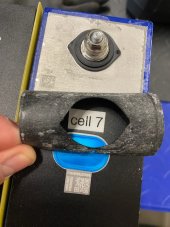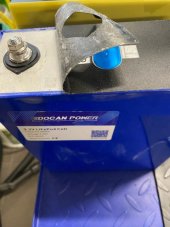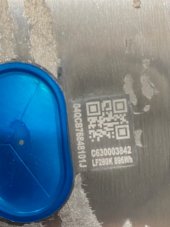Quattrohead
Solar Wizard
The bottom line is there are a lot of underperforming shit reject cells now being pawned off onto us in various disguises, buyer beware.
I have purchased 64x LF280K in October, they arrived just before Christmas and currently testing all the cells. So far we have tested 23 cells. Charge to 3.65. Discharge to 2.70 volt With 40a. The best cell is 280ah (1) and the worst cell 250ah, the others are between 260 and 270ah On average. When all cells are tested I will post the Full results but this will take some time.
All the cells look good, QR codes are valid and no dents or damage. The sides are nice and flat, no signs of any swollen cells.
The plan is to take the 8 worst cells and install these in my camper and replace them with 8 other cells to that my 4 banks of battery average around 260-270 ah.
I tested all codes with a QR scanner and all where valid. All cells where build on the same day 3/June/2022 and the serial numbers are all in a range of 200 following numbers.Please make sure to check date codes with qr scanner app to see when they were made. What tester are you using?
Thanks for your lengthy response!The 304 AH cells have some doping to the electrodes. There are a couple of possible candidates for doping.
One is lithium added to graphite negative electrode. This is to provide self charge forming of the Solid Electrolyte Interface (SEI) layer around graphite. Its primary benefit is to reduce manufacturing time and resource cost of the time-consuming charge forming process. It also reduces the amount of positive LFP cathode electrode lithium used up during normal 280 AH cell charge forming process. This yields about 5% more cell capacity. Downside is there may be a small amount of cell bloating as the cell is sealed during the self-charge forming process and the ohmic resistance will be slightly greater. The small amount of bloating gas will eventually diffuse out through the plastic grommet cell terminal seals.
Other candidate is small amount of graphene added to LFP cathode. Graphene additive adds cost but significantly improves the access yield to lithium from the positive cathode by improving electrical conductivity of LFP cathode. A 280 AH cell relies solely on fine carbon black powder to improve LFP cathode electrical conductivity to a useable level.
My guess is the 304 AH cells have cathode electrode graphene doping. Negative electrode lithium addition alone will not yield enough capacity increase. Curious thing is the 304 AH cells have slightly greater ohmic resistance compared to 280 AH cells, usually over 0.20 milliohms. Graphene alone should reduce ohmic resistance. Maybe both electrodes are doped.
Whenever additives are introduced to electrodes or electrolyte there is always the possibility of unforeseen long term detrimental side effects. Graphene doping has low risk of any detrimental side effects since it is very similar to existing carbon powder which has been used for years.
Only time will tell.
I am probably conservative, so I would likely buy the 280K's. Let the 304 AH's cells get some track record history.Thanks for your lengthy response!
If you were buying cells right now, which cells (vendor?) would you bet?
(in my case, it's for a mobile application - campervan)
Thanks for your detailed response!I am probably conservative, so I would likely buy the 280K's. Let the 304 AH's cells get some track record history.
When I get new cells, I am more concerned about their overpotential voltage slump with load current than how many AH's they have. It only takes 3-4 minutes to test each cell's overpotential load slump voltage so can run through testing the cells fairly quickly.
If a cell has significantly more voltage slump under load it likely means it is a used cell and will have degraded AH capacity.
Match cells for series stacking that have similar voltage slump for same load current.
You need to be able to pull 0.2-0.4 C(A) load current test to get a good voltage slump indication. A 10-20A load tester isn't really enough load for a 280 AH cell.
Does the difference between the LF280 and LF304 have to be doping? You’ve said before electrode thickness affects Ah capacity and peak cell current. Maybe the LF304 is simply a thicker electrode version of the LF280k? The stated max current on the LF304 spec sheet is 250A, which seems low for a cell which is rated for 304Ah, so that would be consistent with a thicker electrode material.My guess is the 304 AH cells have cathode electrode graphene doping. Negative electrode lithium addition alone will not yield enough capacity increase. Curious thing is the 304 AH cells have slightly greater ohmic resistance compared to 280 AH cells, usually over 0.20 milliohms. Graphene alone should reduce ohmic resistance. Maybe both electrodes are doped.
Whenever additives are introduced to electrodes or electrolyte there is always the possibility of unforeseen long term detrimental side effects. Graphene doping has low risk of any detrimental side effects since it is very similar to existing carbon powder which has been used for years.
Only time will tell.
If you just add more LFP and graphite material you have to increase weight and volume of cell.Does the difference between the LF280 and LF304 have to be doping? You’ve said before electrode thickness affects Ah capacity and peak cell current. Maybe the LF304 is simply a thicker electrode version of the LF280k? The stated max current on the LF304 spec sheet is 250A, which seems low for a cell which is rated for 304Ah, so that would be consistent with a thicker electrode material.
I Promised to share my testing results from the Docan power supplied EVE LF280K cells which is finally completed. I ordered 64 cells in total Which were specified as 280 to 270AH cells. I tested all cells with a EBC-A40L tested with the following cycle. All testing was done around 15degC ambient temperature.
The discharge Amp/Hour current was noted.
- Charge to 3.65 volt / 40A
- Wait 30 min
- Discharge to 2.70volt /40 A.
- Charge to 3.4 volt cutoff at 20A.
This means 40% of the cells are not inside the range which was advertised By Docan power.
- From the cells tested 39 cells where in the range of 282ah - 270 ah.
- 19 cells where in the range between 270-260ah
- 6 Cells where below 260 with the lowest cell 255ah.
All cells had valid QR codes and were manufactured 3 June 2022. Link to one of the cells: Gobalpower
Cells internal resistance was between 0.21 - 0.19 ohm, all cells arrived around 3.292 and 3.295 volts. None of the cells where swollen, well packed and the packages included 4 busbars and nuts.
One of the largest variations in the manufacturing process is the printing thickness of graphite and LFP electrodes ink on the copper and aluminum foil, respectively. They measure the final thickness of a foil/electrode after baking on electrodes for the manufacturing lot foil print roll and add or subtract a few turns of laminate wrap to roughly compensate for electrode thickness variation to yield similar AH capacity. It can be based on final lamination roll weight to ensure similar amounts of graphite/LFP material which is closest to telling final cell AH capacity.I Promised to share my testing results from the Docan power supplied EVE LF280K cells which is finally completed. I ordered 64 cells in total Which were specified as 280 to 270AH cells. I tested all cells with a EBC-A40L tested with the following cycle. All testing was done around 15degC ambient temperature.
The discharge Amp/Hour current was noted.
- Charge to 3.65 volt / 40A
- Wait 30 min
- Discharge to 2.70volt /40 A.
- Charge to 3.4 volt cutoff at 20A.
This means 40% of the cells are not inside the range which was advertised By Docan power.
- From the cells tested 39 cells where in the range of 282ah - 270 ah.
- 19 cells where in the range between 270-260ah
- 6 Cells where below 260 with the lowest cell 255ah.
All cells had valid QR codes and were manufactured 3 June 2022. Link to one of the cells: Gobalpower
Cells internal resistance was between 0.21 - 0.19 ohm, all cells arrived around 3.292 and 3.295 volts. None of the cells where swollen, well packed and the packages included 4 busbars and nuts.
I'm pretty happy so far with my Grade B LF304 purchase from 18650. All the cells have tested out at 315 Ah on my little fan tester with its 20A max load. Even the Wh capacity seems pretty good despite voltage drops in my connections and in the electronic load. Testing was done on individual cells. I'll be doing a high capacity test once the battery is built and hooked up to a 2000W inverter.







